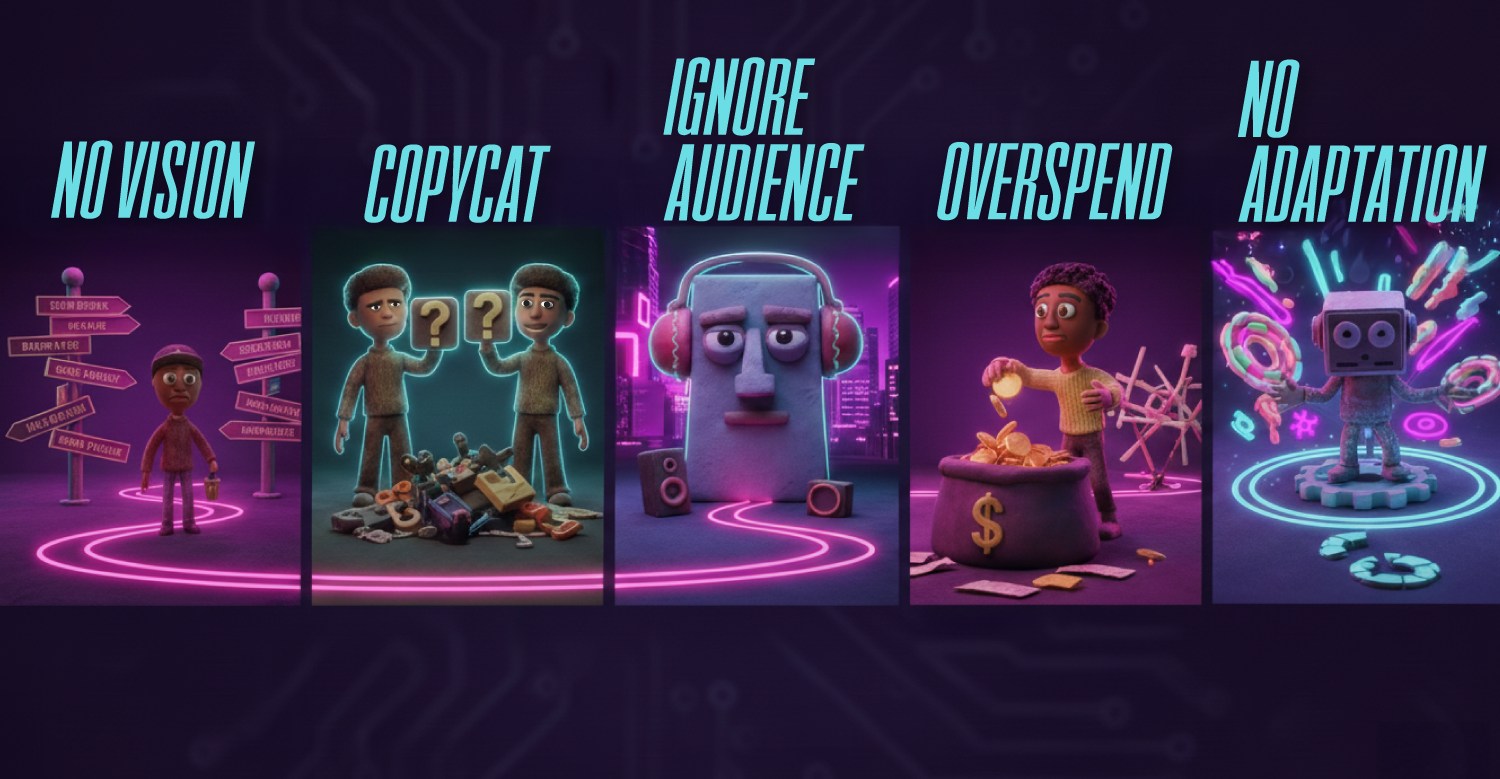5 Mistakes Startups Make When Building a Brand …
How to Avoid Becoming Another Casualty)
Author - Joey Hill, Owner, Hill + Co. Creative
Building a startup brand in 2025 is like assembling IKEA furniture while blindfolded—you think you have all the pieces, but somehow you end up with a wobbly mess that doesn't look anything like the picture. After two decades of watching brilliant entrepreneurs stumble over the same branding pitfalls, I've identified five critical mistakes that turn promising startups into cautionary tales.
1. Playing Brand Charades Instead of Being Authentic
The Mistake: Trying to be everything to everyone, like a dating app profile that lists "hiking" when you haven't left your couch since the Tiger King era.
Remember when Theranos convinced the world they were the next Apple? Elizabeth Holmes didn't just fake technology—she faked an entire brand persona, complete with a manufactured Steve Jobs aesthetic. The result? A $9 billion house of cards that collapsed faster than a Jenga tower in an earthquake.
The Fix: Authenticity isn't just a buzzword your Gen Z marketing intern throws around. It's your North Star. Define your core values and stick to them like they're sacred family recipes passed down from your great-grandmother. Nike didn't become iconic by trying to please everyone—they took a stand with Colin Kaepernick, knowing they'd lose some customers but gain unwavering loyalty from others.
2. Logo Tunnel Vision (AKA Missing the Forest for the Trees)
The Mistake: Obsessing over logo perfection while ignoring the brand ecosystem, like rearranging deck chairs on the Titanic.
I've watched startup founders spend three months debating whether their logo should be "Pantone 286 C" or "Pantone 285 C" blue, while their customer service sounds like a robot having an existential crisis. Your logo isn't your brand—it's just the face on your brand's driver's license.
The Historical Reality Check: Coca-Cola's original logo was literally just the founder's bookkeeper's handwriting. What made it iconic wasn't the typography—it was 130+ years of consistent brand experience and emotional connection.
The Fix: Think of your brand like The Avengers. Your logo is just Iron Man's face mask—important, but useless without the suit, the personality, the mission, and the team behind it. Focus on your entire brand ecosystem: voice, values, customer experience, and visual identity working together like a well-orchestrated Marvel movie.
3. The "We're Different" Syndrome Without Proof
The Mistake: Claiming to be "disruptive" or "revolutionary" without actually disrupting anything, like every cryptocurrency project in 2021.
Every startup founder thinks they're Neo from The Matrix, believing they've discovered something no one else has seen. But here's the harsh truth: saying you're different doesn't make you different. It's like claiming you're the main character in everyone else's story—it might feel true to you, but nobody else is buying tickets to that movie.
The Fix: Stop telling people you're different—show them. Dollar Shave Club didn't announce they were revolutionizing razors; they made a hilarious video that demonstrated their value proposition in 90 seconds. Be the Banksy of your industry: let your work speak so loudly that your words become unnecessary.
4. Brand Consistency That's More Inconsistent Than Ross and Rachel
The Mistake: Having a brand personality that changes more often than a mood ring, creating customer whiplash.
Your brand voice shouldn't sound like it has multiple personality disorder. If your Instagram sounds like Shakespeare, your email campaigns read like a tech bro's LinkedIn post, and your customer service talks like Yoda, customers won't know which version of you to trust.
The Modern Example: Look at how seamlessly brands like Amazon maintain their voice across every touchpoint—from their minimalist packaging to their Instagram stories to their customer emails. It's like they have one person writing everything (they don't, but they might as well).
The Fix: Create a brand bible that's more sacred than your grandmother's secret cookie recipe. Document everything: tone of voice, visual guidelines, messaging pillars, and brand personality traits. Then treat it like the Constitution—something that guides every decision but can be amended when necessary.
5. Building for Today's World with Yesterday's Mindset
The Mistake: Creating brands for a world that no longer exists, like opening a Blockbuster in 2025.
Too many startups build brands based on traditional corporate playbooks, ignoring the fact that modern consumers grew up with social media, expect transparency, and can smell corporate BS from a mile away. They're creating brands for Mad Men when their customers are living in the age of TikTok and Twitter threads.
The Reality Check: Your customers don't want to be sold to—they want to be part of your story. They don't want perfect; they want real. They don't want corporate speak; they want conversations. Duolingo became a social media sensation not by being a perfect language app, but by having a sassy owl personality that threatens users on Twitter.
The Fix: Build your brand like it's 2025, not 1995. Embrace community over customers, conversations over campaigns, and values over vanity metrics. Be human enough that people want to grab coffee with your brand, but professional enough that they trust you with their money.
The Bottom LinE
Building a brand isn't about creating a logo and calling it a day—it's about crafting an experience that makes people choose you over everyone else, even when logic suggests they shouldn't. It's about becoming so embedded in your customers' lives that switching to a competitor feels like betraying a friend.
The startups that survive and thrive aren't necessarily the ones with the best products—they're the ones with the strongest, most authentic brands. In a world where consumers have infinite choices and zero patience, your brand isn't just your competitive advantage—it's your survival strategy.
Don't let your startup become another cautionary tale. Build a brand that would make Don Draper proud but keep it real enough for the TikTok generation to stan.
Ready to build a brand that actually works? Let's talk. Because in the startup world, you're either building a brand or becoming someone else's cautionary tale.

